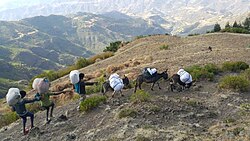Ambassel
ዐምባሰል | |
|---|---|
 | |
 | |
| Country | Ethiopia |
| Region | Amhara |
| Zone | Debub Wollo |
| Area | |
• Total | 882.24 km2 (340.63 sq mi) |
| Population (2012 est.)[2] | |
• Total | 132,157 [1] |
Ambassel (Amharic: ዐምባሰል) is a woreda in Amhara Region, Ethiopia, and an amba, or mountain fortress, located in the woreda. The word Ambasel is derived from two words "Amba" from the Amharic word for plateau, and “Asel” from the Arabic language, which means honey. Together, it means “plateau of honey” or the “land of honey” [3] the woreda is named for this feature. Located in the Debub Wollo Zone, Ambassel woreda is bordered on the west by the Bashilo which separates it from Tenta, on the north by the Semien Wollo Zone, on the southeast by the Mille River which separates it from Tehuledere, and on the south by Kutaber; the Walano, a tributary of the Bashilo, defines most of its southern border. Its largest town is Wuchale.
Elevations in this woreda range from 1200 to 3200 meters above sea level; the divide between the drainage areas of the Nile and the Awash runs through the middle of Ambassel. Rivers include the Waha Titu. Notable landmarks include Amba Geshen, where the medieval Emperors of Ethiopia would confine their male relatives to keep them from threatening his power.[4] Ambassel has proven deposits of coal near Wuchale, which were exploited during the Italian occupation.[5]
- ^ "GeoHive - Ethiopia population statistics". www.geohive.com. Archived from the original on 5 August 2012. Retrieved 12 January 2022.
- ^ a b Geohive: Ethiopia Archived 2012-08-05 at the Wayback Machine
- ^ Alebachew, Getachew Worku; Eshetie, Tewabe Mihret (23 July 2019). "Assessment of Beekeeping Practices of Youth Groups in Eastern Amhara, Ethiopia". Bee World. 97 (4): 117–122. doi:10.1080/0005772X.2019.1637191. S2CID 199629601.
- ^ Svein Ege, South Wälo 1:100,000. Topographic and administrative map of South Wälo Zone, Amhara Region, Ethiopia. Archived 2011-07-18 at the Wayback Machine Trondheim, NTNU, 2004
- ^ "Local History in Ethiopia" Archived 2008-10-31 at the Wayback Machine The Nordic Africa Institute website (accessed 15 February 2008)
